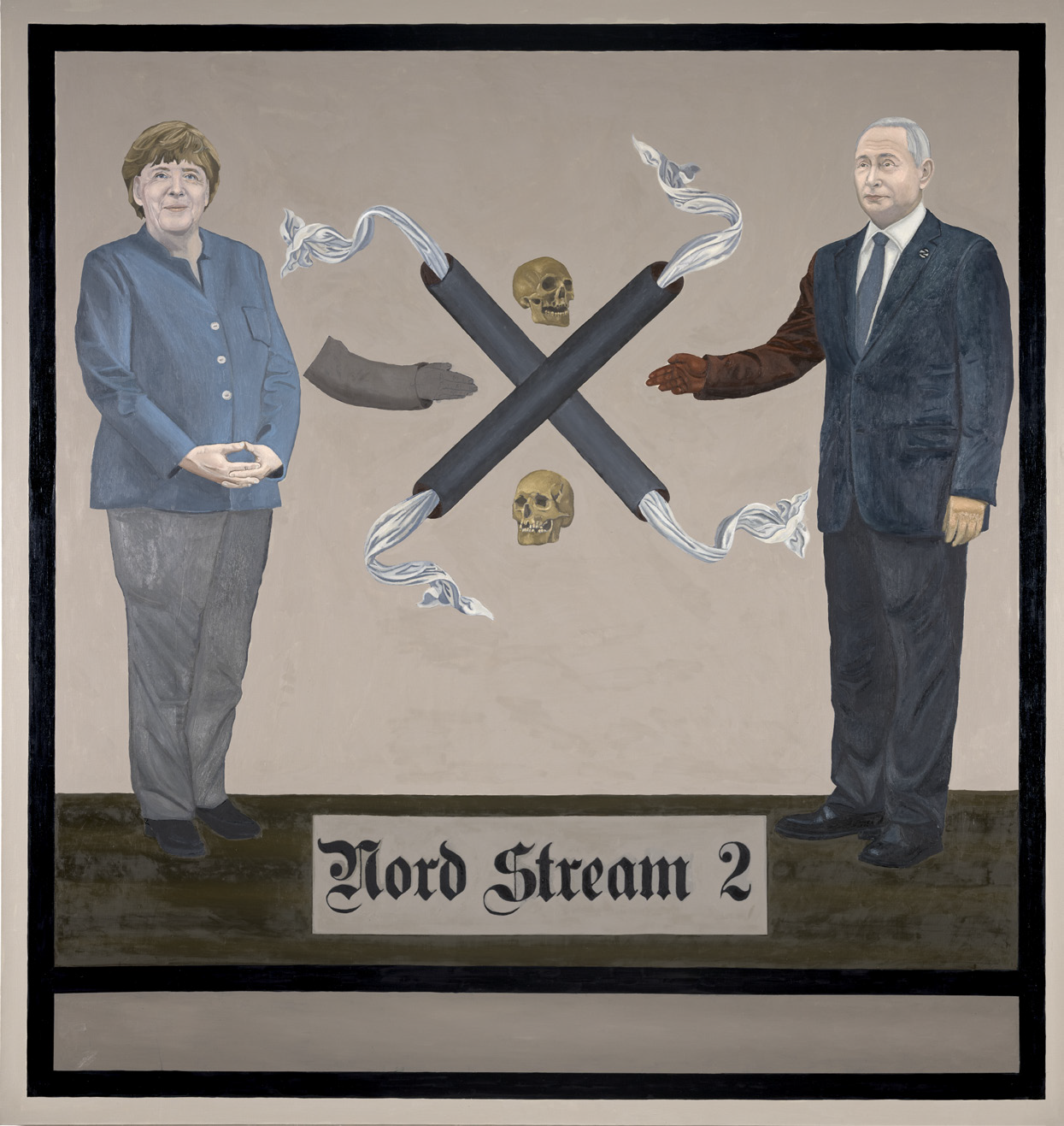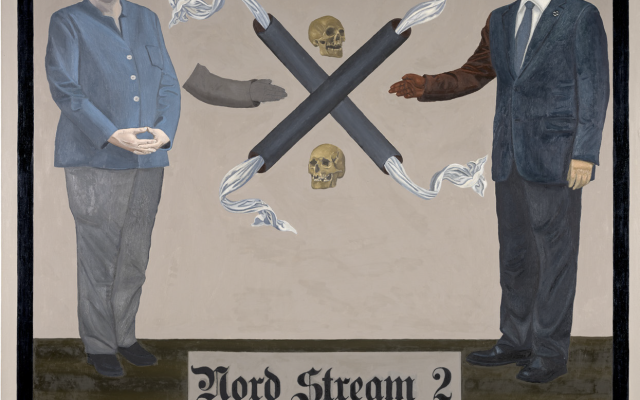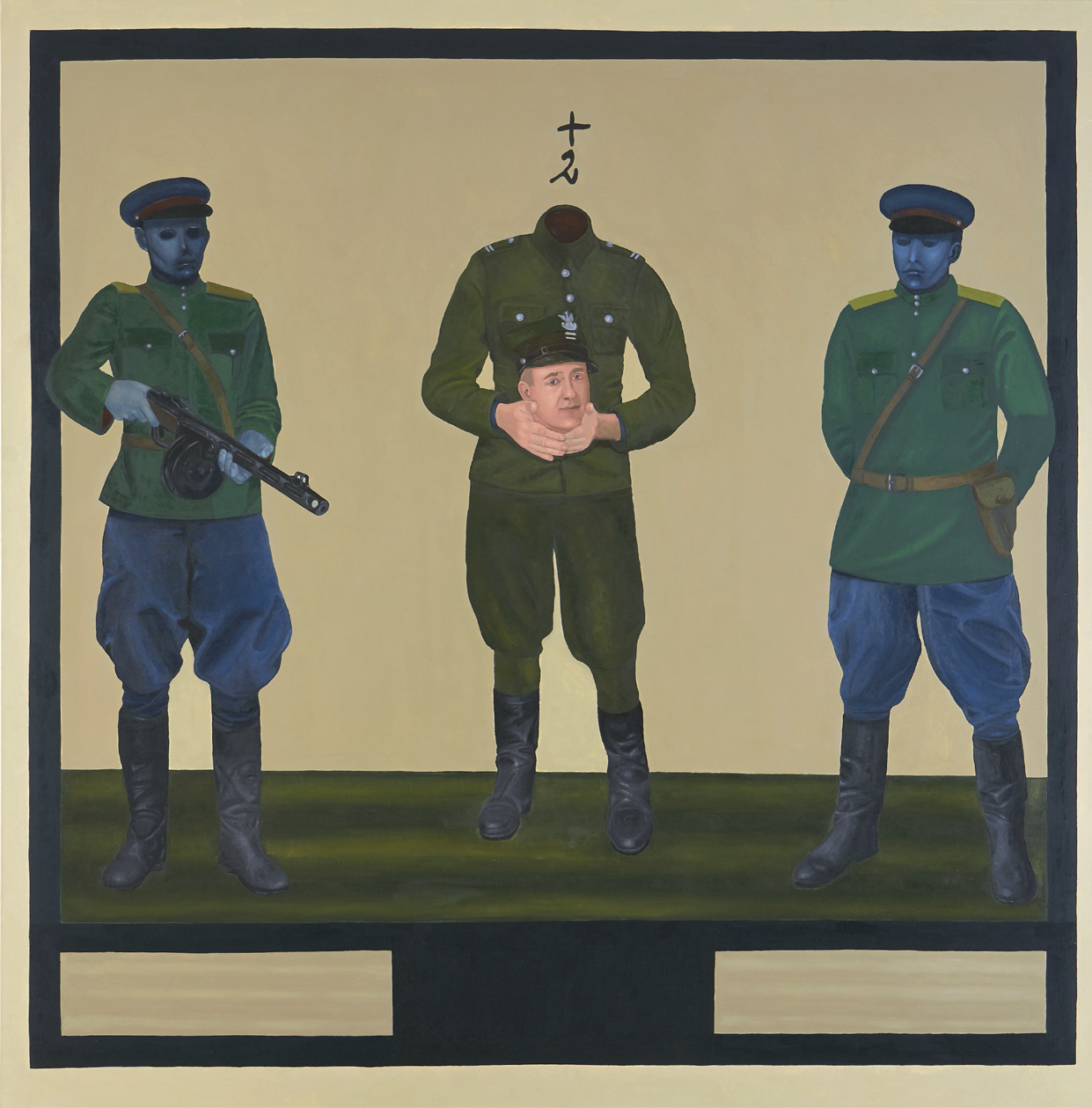20th September 2023
The Competition Committee for the 2024 exhibition in the Polish Pavilion at Venice Biennale is in session – phase II. Jury consisting of: prof. Elżbieta Banecka, Andrzej Biernacki, prof. Tadeusz Boruta, Jarosław Denisiuk, Jagna Domżalska, Janusz Janowski PhD (chairman of the Jury), Janusz Kapusta, Agnieszka Komar-Morawska, Zbigniew Makarewicz PhD, Maciej Mazurek PhD, prof. Kazimierz Nowosielski PhD, Urszula Święcicka, Joanna Warsza, Karolina Ziębińska-Lewandowska PhD. The jury recognised the project 'Polish Exercises in the Tragedy of the World. Between Germany and Russia' by artist Ignacy Czwartos and curators – Piotr Bernatowicz and Dariusz Karłowicz, as the best. In the voting process, the project received 11 out of 14 votes. This is what the curators wrote about the idea of the winning project:
The exhibition by Ignacy Czwartos that we are presenting at the Venice Biennale is the fruit of a profound reflection on the tragic history of the 20th century. From the depths of his Polish experience, the artist tells us: "The tragic nature of the world is its inalienable characteristic. The world is not made up of simple patterns, it is full of irreconcilable contradictions, conflicts of interests and ideas, dilemmas that have no simple solutions. The Greeks invented tragedy. The Poles rehearsed it. The scene of Polish tragedy lies between Germany and Russia. In the twentieth century, this meant experiencing two bloody totalitarianisms that remained in a relationship that, according to François Furet and Ernst Nolt, could be called "hostile proximity". Although they differed in their diagnosis of reality, their ideals and their objectives, they were united by the conviction that violence, terror and annihilation were necessary. But that is not the only similarity. The common basis of both systems was the belief in the possession of complete causality and knowledge - qualities which in the European spiritual tradition were attributed exclusively to God.
A proposal from the Open Group of Ukrainian artists and a Polish curator was selected as a reserved project.
Three members of the jury (Jagna Domżalska, Jaonna Warsza, Karolina Ziębińska-Lewandowska) issued a public dissenting statement in which they expressed their negative opinion of the winning project, which, in their opinion:
presents an image of Poland as a homogeneous, closed country, focused only on itself and speaking from a position of victimhood, and does not reflect the state of the contemporary Polish art scene.

Ignacy Czwartos, Hermann Schaper - German Criminal
(pl. Hermann Schaper - niemiecki zbrodniarz), 180x180 cm, oil on canvas, 2023
However, they do not provide any arguments for this position. Does an image of a homogeneous country automatically emerge from a project that talks about the Polish experience and presents Poland as a victim of totalitarianism? After all, the two totalitarianisms against which the project is directed (as well as any updating of totalitarian thinking) destroyed the Second Republic's unique multiculturalism. Simultaneously, they speak positively about the other projects, including the one they voted for:
We believe that the other two projects analysed in the second phase of deliberations - the Ukrainian collective Open Group's proposal and Own's collective proposal - formally and ideologically represent the values we want to defend: openness, tolerance, care, empathy, opposition to armed conflicts.
This statement implies that the project 'Polish Exercises in the Tragedy of the World. Between Germany and Russia' does not oppose armed conflicts, which is not true.
Before the public gets to know the winning project's assumptions, the opinion of three jury members who voted against Ignacy Czwartos' exhibition design is published. On the same day, Gazeta Wyborcza published an article by Witold Mrozek entitled: He paints football fans and 'cursed soldiers'. Is he the one to represent Poland at the Venice Art Biennale? (Orig. title: Maluje kibiców i "żołnierzy wyklętych". To on ma reprezentować Polskę na Biennale Sztuki w Wenecji?)[1], reports the results of the competition. The title itself is a manipulation. Unlike painters such as Marcin Maciejowski, for example, Czwartos does not paint fans. He paints himself, his children and other artists wearing fan scarves, which in his paintings become something between a priest's stole (a rather ironic reference to football's quasi-religious treatment) and a historical polish nobleman's belt (kontusz). Football fans, stadiums and all the associated settings do not appear in his paintings. The author's intention is to create for Wyborcza readers with intellectual aspirations an image of a not very cultured person from the fan community (it also has a whiff of superiority - the assumption that these are people of low culture, which is, after all, a cliché). Can such a person be a representative of Poland at one of the most important art exhibitions in the world? Absolutely not! - is what a concerned reader of Wyborcza should be thinking.
Articles in the press and other online magazines are published in a similar manner. The media in Poland (Newspapers: Wyborcza, Rzeczpospolita; Weeklies: Polityka, Newsweek; Internet Portals: onet.pl, wp.pl) represent virtually the same left-liberal line. They give the impression of a multitude of voices, when in fact there is only one voice; often even parts of the texts are similar.
31st October 2023
The Minister of Culture and National Heritage, Professor Piotr Gliński, has finally accepted the selection of the jury for the Ignacy Czwartos exhibition in the Polish Pavilion at the 60th Biennale in Venice. Why was there such a delay in the decision? Did he not, with this delay, favour the left-wing critics who are trying to accuse the selection of a certain ambiguity? Such doubts are raised by Amelia Sarnowska in an article published on Onet.pl, titled Mr Director's colleagues, a short bench and "Polish pain". This is the backstage of the Polish competition at the Venice Biennale (Orig. title: Koledzy pana dyrektora, króka ławka i "polski ból". Oto kulisy polskiego konkursu na Biennale w Wenecji)[2], which talks about the allegedly problematic backstage of the selection of Ignacy Czwartos' exhibition project.
Through the voice of an anonymous interlocutor, the Ringier Axel Springer online magazine tries to create an atmosphere of controversy and nepotism around the selection of Czwartos' project. The problem arises because the jury was chaired by Janusz Janowski, who had previously curated Czwartos's exhibition at the Zachęta Gallery. However, the author fails to inform the reader that the director of the Zachęta Gallery is always the chairman of the jury, as it is the Zachęta Gallery that takes care of the Polish pavilion in Venice. In all previous competitions this has been the case. Moreover, it was not Janowski who submitted the design for the pavilion - the competition was open to everyone, including Czwartos. Even if Janowski had abstained from voting, Czwartos's design would still have won with an overwhelming majority of the jury's votes. The text is riddled with value assessments from an unknown source - an anonymous but experienced employee of Zachęta. A significant sentence of the text reads as follows:
It's not just the Czwartos’ project itself that's controversial, but also the composition of the committee and changing the rules of procedure - these are nuances, but they are a great advantage over those who are running without a fellow director on the committee.
Why does the author see a problem with the jury? Well, according to an anonymous informant, the wrong people are on it.
For example, Agnieszka Knast, who was on the previous jury, is an internationally recognised cultural manager who has led many major institutions in her career and is currently the director of the National Gallery in Prague. And the result of this year's commission by Tadeusz Boruta is something else. A minor painter associated with the Rzeszów University - writes Sarnowska.
Why should the achievements and experience of Agnieszka Knast, a trained musicologist, be so much superior to those of Professor Tadeusz Boruta PhD, a painter and curator active on the Polish art scene since the 1980s? If it were a question of choosing the director of an institution, I would agree with the author - I do not question Alicja Knast's managerial experience, but it was a question of choosing an artistic project (I would also like to draw attention to the fact that Tadeusz Boruta was stripped of his academic title, as this could weaken Ms Sarnowska's thesis of his low competence).
12th November 2023
Philip Oltermann's article in the left-leaning British daily The Guardian is entitled: 'An anti-European manifesto': Poland's Venice Biennale entry defies inclusive theme. The title quotes Karolina Plinta, a critic for the left-wing Polish art magazine Szum, who commented on the project and the artist's painting:
Czwartos's paintings are an eclectic mix of everything that will please the conservative imagination. If his show goes ahead as planned, the Polish pavilion will amount to an anti-Russian but also an anti-European manifesto.

Ignacy Czwartos, Nord Stream 2, 200x190 cm,
oil on canvas, 2024.
The author does not elaborate on this idea, or perhaps she did, but The Guardian did not see fit to include it. So where does this anti-Europeanism come from? There is nothing about Europe in the title of the project. Nor is Europe the main theme in the content of the project, and when it is, it is in a positive rather than a negative light. Instead, it mentions Russia and Germany. One of the paintings to be created for the exhibition was supposed to show the leaders of Russia and Germany united not by a swastika, as the media wrote, but by the Nord Stream pipeline, which is in the shape of that unfortunate swastika. If I wanted to interpret this non-existent image, I would refer, for example, to the famous work of the Czech artist David Cerny, who in his giant sculpture, which was once exhibited as part of the Czech Presidency of the EU, incorporated a swastika made of motorways into the outline of Germany. As you can see, this swastika in the context of contemporary Germany is not only in the minds of 'pissowski' artists (invective reference to sympathizer of the PiS - Law and Justice party) like Czwartos, but also of artists who have nothing to do with Poland. At the time, way before Putin's brutal attack on Ukraine, Cerny's work aroused much interest and even controversy, but it never occurred to anyone to call it an anti-European manifesto.
Nowadays, criticising German policies automatically assumes the dimension of an anti-European manifesto.
Karolina Plinta simply rewrote part of the title 'between Germany and Russia', recognising that 'between' means as much as 'against'. She simply replaced 'Germany' with 'Europe'. And that is how an anti-European manifesto came into being. I don't think this substitution was dictated by someone in the German embassy in Warsaw. Rather, it was an automatic substitution following the now-common belief that Germany=Europe. For German soft power, this can be seen as a great success. The entire United Right in Poland should immediately go to our western neighbours for tutoring.
Apart from statements made by Karolina Plinta and one of the jury members, Joanna Warsza, neither the artist nor the curators were quoted. No one contacted them for this purpose.
13th October 2023
Gazeta Wyborcza immediately informs its readers about the text in the Guardian: 'Anti-European manifesto'. "Guardian on Polish artist promoted by the Ministry of Culture (published 13th Oct 2023 at 14:20)[3]. The author of the article is the indefatigable editor Mrozek. And so the statement made by a critic from the niche magazine Szum is published as the position of the "foreign press" regarding the Ignacy Czwartos Exhibition Project.
"The most important British newspaper writes about the Ignacy Czwartos’ exhibition project that Minister Gliński is sending to the most important event of the art world in Venice. And asks the Lithuanian Foreign Ministry about the crimes of 'Łupaszka'" Mrozek begins. Of course, he does not mention that the Guardian is a left-leaning newspaper. And why does he consider it the most important newspaper in Britain? For the Left, perhaps. He also makes no reference to the Guardian's reply from Lithuania's Foreign Ministry, whose representative says it will not comment on art and history because that is the job of art critics and historians. But the existence of undeniable 'crimes' is suggested by the question itself. Obviously, the Guardian's writer is unaware that Lupashka's crimes were attributed to him by the Communists, who themselves persecuted and brutally murdered both Lupashka and soldiers like him. So they could hardly be objective in their assessments. However, apart from Gazeta Wyborcza, the Guardian's writer is probably unfamiliar with other sources of Polish history. Gazeta Wyborcza, in turn, quotes the Guardian, and so the circle of self-confirming information comes full circle.
Ignacy Czwartos, ‘Stryj’ Soldiers (pl. Żołnierze “Stryja”),
200x190 cm, oil on canvas, 2022.
20th December 2023
Gazeta Wyborcza publishes an interview with Anda Rottenberg (an influential art critic associated with the current government, former official at the Ministry of Culture and Arts and director of the Zachęta National Gallery of Art): Anda Rottenberg: 'Blood, sweat and tears’ await us after the Law and Justice governments (Orig. title: Andra Rottenberg: Po rządach PiS-u czekają nas “krew, pot i łzy”), in which she states that the director of Zachęta, Janusz Janowski PhD, should be dismissed and the Ignacy Czwartos exhibition project in Venice should be cancelled - there is still time until 13 January. And as if to fulfil the wish (or order) of Anda Rottenberg, on 22 December, just before Christmas, Minister of Culture Bartłomiej Sienkiewicz promptly dismissed Janusz Janowski PhD, from his post as director of Zachęta Gallery, thus breaking the contract legally concluded with him and valid until the end of 2025.
29th December 2023
After only a week, the acting director of Zachęta - Ms Justyna Markiewicz (a close associate of Hanna Wróblewska, with whom she sits on the board of the Zachęta Fine Arts Society at the Zachęta National Gallery of Art) - terminated the contract concluded with the team of the project "Polish Exercises in the Tragedy of the World. Between Germany and Russia', explaining the Minister justified the decision on the basis of the competition rules. However, it turns out that according to the Competition Regulations, the minister cannot decide to withdraw a project that has already been accepted. Moreover, according to the Competition Regulations, such a change can only be made in the case of objective and/or fortuitous circumstances, and the decision in such a case is made by the Director of Zachęta. Isn't this the reason why it was necessary to get rid of Janowski as quickly as possible, which resulted in the breach of a legal contract? Just the way Anda Rottenberg had in mind.
To further complicate or ridicule the issue, the website of the Ministry of Culture and National Heritage publishes the information that Minister Sienkiewicz agreed to the decision (by whom? who made the decision and when?) to withdraw the project already selected and accepted for the Biennale in Venice, after analysing the competition procedures (what is so unclear about these procedures?) and consulting the opinions and voices of the community (which voices? which community?). Instead, he chooses a reserve project created by the Open Group collective, selected through the same competition (so the procedures were good after all?).
Were a few unreliable newspaper articles enough to make a decision that was in breach of the competition rules? Apparently so. That's how censorship works: first of all - nomen est omen - public opinion has to be turned against the person in question and his or her actions, and then the politician snaps his or her fingers and it's done. The only thing to do now is to put the Czwartos exhibition behind us as quickly as possible and present the ministers' new picks.
Ignacy Czwartos, Epitaph for Józef Franczak ‘Lalek’
(pl. Epitafium dla Józefa Franczaka “Lalka”),
200x200 cm, oil on canvas, 2018.
3rd January 2024
At the beginning of the New Year, when the offices have returned to work after the New Year's New Year's Eve party, an elegant photo of a smiling Minister accompanied by the Open Group collective appeared on the pages of the Ministry of Culture and National Heritage with a note:
Curator Marta Czyż and Open Group artists Yuriy Biley, Pavlo Kovach and Anton Varga today received the decision from Minister of Culture and National Heritage Bartłomiej Sienkiewicz on the participation of their project Repeat After Me II at the 60th International Art Exhibition in Venice. The selected project, which is the result of a long-term collaboration between the curator and the Open Group artists, will be presented in the Polish Pavilion.
The plan to cancel the Ignacy Czwartos’s exhibition in Venice was carried out ten days ahead of schedule.
[1] W. Mrozek, Maluje kibiców i "żołnierzy wyklętych". To on ma reprezentować Polskę na Biennale Sztuki w Wenecji?, „Gazeta Wyborcza”, article dated 20.09.2023, available at www.wyborcza.pl (accessed:18.02.2024).
[2] A. Sarnowska, Koledzy pana dyrektora, krótka ławka i "polski ból". Oto kulisy polskiego konkursu na Biennale w Wenecji, article dated 04.11.2023, available at www.onet.pl (accessed: 18.02.2024).
[3] W. Mrozek, "Antyeuropejski manifest". "Guardian" o polskim artyście, którego promuje ministerstwo kultury, Gazeta Wyborcza, article dated 13.11.2023 available at www.wyborcza.pl, (accessed 18.02.2024).




